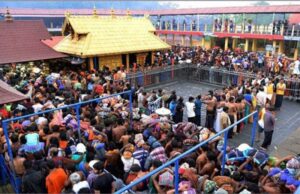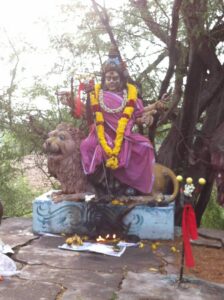Women as temple priests: Mixed response by community
On June 12, Tamil Nadu minister for Hindus Religious and Charitable Endowments PK Sekar Babu said that women can become priests after getting proper training of Agama Shastra to worship and rituals at temples.
Within hours of his statement, the statement ballooned into a major controversy, splitting the devotees vertically as some saw it as a push for gender equality and freedom of religion, while others called it an unnecessary interference in religious beliefs.
Shivani, a 27-year-old housewife in Chennai, welcomes the change, saying it will lead to a major positive change in the society. “I don’t feel odd about women priests. At home, it is mainly women who perform all prayers, then why not in temples? Not only in Tamil Nadu, but all over India, women should be priests, with needed qualification, intelligence, courage and dedication. It will go a long way in countering our social ills like discrimination based on religion, caste or economic status,” Shivani tells Media India Group.
However, there were many who were strongly critical of the decision and they were quick to take to social media to display their anger. Many said that the government should not interfere with Agama Shastra, a Hindu manual governing prayers and rituals in temple besides guidelines on structure and construction of shrines.
“I have been worshipping in the temple for more than 20 years. Before I could join here, I had to learn all the mantras and the way to worship from my father, who also served as a priest until his last breath,” Sudharshan, a 38-year-old priest in Pasar, a small village near Kallakurchi district in Tamil Nadu.

Sabarimala temple remains out of bounds for women between 10-50 years even though Supreme Court has allowed women to offer their prayers there
“I strongly disagree with letting women become priests after getting Agama Shastra training, as the rules are different and traditions are different,” says Sudharshan, adding “the sun rises in the east, you can’t change that. Similarly, you can’t change traditional practices which have been followed for over thousands of years. The government should concentrate on maintaining the temples, necessary arrangement needed in the temples, rather than getting involved in internal matters of temple,” says Sudharshan.
Even Sudharshan’s wife Jothika is against the new rule. “As we all follow our ancestors’ way of being vegetarian, and other rituals that are followed by every Brahmin family, in the same way our ancestors gave us this, Brahmins as a purohit(priest). True god-fearing women themselves will not be willing to enter sanctum to do the rituals. Will you allow women to enter Sabarimala temple? We don’t need any changes regarding temples,” says Jothika in a high-pitched voice.
Lots of restrictions even with a deity
In 2008, Madras High Court allowed a woman to officiate as priest and to conduct pujas in a temple after her father’s death. Pinniyakkal was the only heir to her father and she had been performing prayers and rituals in the temple from 2004 when her father was sick. But after her father died, she had to stop because of villagers’ objections.
In the order, the judge observed that neither any provision of law nor any scheme prohibited women from performing prayers in the temples.
The main reason behind the objections of conservative section of the society to having women as priests is menstruation, that many Hindus, including women, consider to be impure. This is the reason why women between ages of 10-50 years cannot even enter the Sabarimala temple in neighbouring Kerala.
Before visiting the Sabarimala Ayyapan temple, devotees typically observe fast for 48 days and follow several rituals. Even when going to the temple, the devotees have to abide by several regulations to mount the pathinettu padikal (18 steps) and enter the temple.
Not just in India, restrictions on women regarding prayers prevail in Nepal as well. For instance, Shaligram Shila is a holy stone that is found in the bed of Gandaki river in Nepal, which is prized by devotees of Lord Vishnu. But no woman is allowed to touch these stones.
But why can’t a woman worship a goddess
In his declaration, Tamil Nadu minister MK Sekar Babu tried to address the issue of menstruation. He said that the qualified women priests who have been given proper training in Agama Shastra would be eligible for 5-day leave during their menstruation.
Many who object to the old rituals and traditions widely prevalent in the Hindu society say it is ironical that when presiding deity of the temple is often a Goddess, people raise objections against a woman performing as a priest.

Sri Periyayi Amman temple
Vishvanth Hari is a 54-year-old priest of Ulagalantha Perumal temple in Tirukoilure in Villupuram district of Tamil Nadu. “Though Hinduism by itself does not ban the practice of women becoming priests, it is just the tradition that has been followed for several generations that men shall be priests. When people have no problem in worshipping goddess, then why should they have any objection regarding women becoming priests, when the women are willing to do so,” Hari tells Media India Group.
Melmaruvathur is one of the most famous temples in Tamil Nadu and each year, thousands of devotees go to see the deity Adhiparashakti Amman. The temple in Melmaruvathur town, about 100 km south of Chennai, already has women priests. It is a vibrant example of how women can be acceptable as temple priests.
Melmaruvathur is hardly the sole example. Non-Brahmins priests are already working in many temples and many women are already performing prayers in many Amman temples and also work as astrologers. “Women priests already exist in our state, but very few. I agree with the decision, but the concerned department should check whether they are properly eligible to do this with dedication,” says Hari.
However, he says the security of women priests is one of the factors that need to be addressed before women can officiate as priests. “A woman becoming a priest is not an issue, but there will be some practical difficulties, including security. For early morning prayers, a priest has to reach the temple, by 3:30 or 4am to make necessary arrangements. If women were appointed, then there may be a security concern,” he says.
Even though as of now a lot of people are against women priests, but the ones who support this say it will be a big push for equality and respect for women in the Indian society that seems to have remained stuck in the 18th century in its beliefs and traditions, much to the detriment of women and the underprivileged sections.










